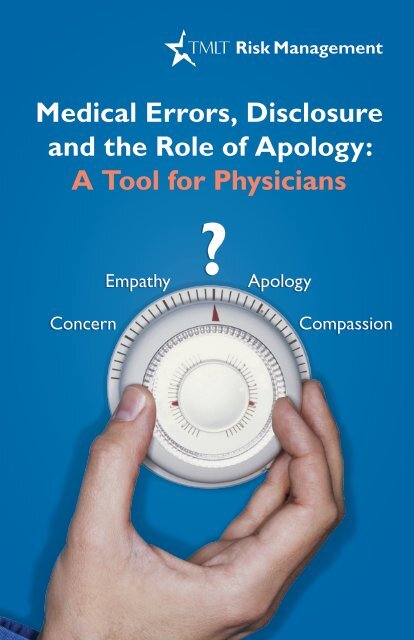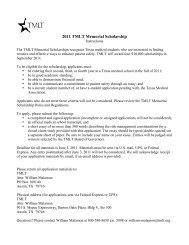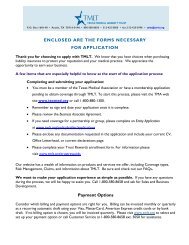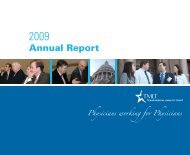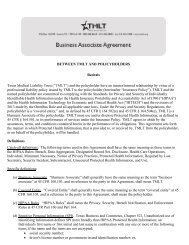Medical errors, disclosure, and the role of apology: a tool for ... - TMLT
Medical errors, disclosure, and the role of apology: a tool for ... - TMLT
Medical errors, disclosure, and the role of apology: a tool for ... - TMLT
You also want an ePaper? Increase the reach of your titles
YUMPU automatically turns print PDFs into web optimized ePapers that Google loves.
<strong>Medical</strong> Errors, Disclosure<br />
<strong>and</strong> <strong>the</strong> Role <strong>of</strong> Apology:<br />
A Tool <strong>for</strong> Physicians<br />
Empathy<br />
<br />
Apology<br />
Concern<br />
Compassion
901 Mopac Expressway South<br />
Barton Oaks Plaza V, Suite 500<br />
Austin, TX 78746-5942<br />
PO Box 160140<br />
Austin, TX 78716-0140<br />
800-580-8658<br />
512-425-5800<br />
Fax: 512-425-5996<br />
The only health care liability claim trust created <strong>and</strong> endorsed by Texas <strong>Medical</strong> Association<br />
Written by George F. (Rick) Evans, Jr.<br />
Evans & Rowe<br />
San Antonio, Texas<br />
All articles <strong>and</strong> any <strong>for</strong>ms, checklists, guidelines <strong>and</strong> materials are <strong>for</strong> generalized<br />
in<strong>for</strong>mation only, <strong>and</strong> should not be reviewed or referred to as primary legal<br />
sources nor construed as establishing medical st<strong>and</strong>ards <strong>of</strong> care <strong>for</strong> <strong>the</strong> purposes<br />
<strong>of</strong> litigation, including expert testimony. They are intended as resources to<br />
be selectively used <strong>and</strong> always adapted – with <strong>the</strong> advice <strong>of</strong> <strong>the</strong> organization’s<br />
attorney – to meet state, local, individual organizations <strong>and</strong> department needs<br />
or requirements. They are distributed with <strong>the</strong> underst<strong>and</strong>ing that nei<strong>the</strong>r<br />
Texas <strong>Medical</strong> Liability Trust nor Texas <strong>Medical</strong> Insurance Company is engaged in<br />
rendering legal services.
Preface<br />
In recent years, health care providers have become cautious about <strong>of</strong>fering<br />
expressions <strong>of</strong> empathy or sympathy to patients who have suffered adverse<br />
outcomes. These outcomes may be <strong>the</strong> result <strong>of</strong> known complications, clear<br />
<strong>errors</strong>, or o<strong>the</strong>r circumstances. The health care providers’ caution in this area <strong>of</strong><br />
communication is <strong>the</strong> result <strong>of</strong> <strong>the</strong> increasing number <strong>of</strong> lawsuits filed against <strong>the</strong>m<br />
by <strong>the</strong>ir patients.<br />
Physicians underst<strong>and</strong>ably have a difficult time determining appropriate<br />
communication techniques to convey concern <strong>for</strong> <strong>the</strong> patient without<br />
inadvertently implying <strong>the</strong>ir own fault or guilt. It is not unusual <strong>for</strong> a physician’s<br />
compassionate <strong>and</strong> empa<strong>the</strong>tic actions to be misunderstood <strong>and</strong> later described to<br />
a jury as an <strong>apology</strong> <strong>for</strong> his error.<br />
Unquestionably, <strong>the</strong>re are situations in which clear <strong>errors</strong> have been committed.<br />
Although rare, those events should certainly be followed with a sincere <strong>apology</strong><br />
<strong>and</strong> appropriate assistance to <strong>the</strong> patient. In situations where <strong>the</strong> physician is not<br />
at fault <strong>for</strong> <strong>the</strong> undesired outcome, or when responsibility is difficult to determine<br />
prior to an investigation, it is still important <strong>for</strong> physicians to have <strong>the</strong> skills<br />
necessary to express empathy <strong>and</strong> concern without suggesting to <strong>the</strong> patient that<br />
<strong>the</strong>y bear legal responsibility.<br />
Recent studies have suggested that failing to apologize <strong>for</strong> clear <strong>errors</strong> may<br />
prompt more claims than previously suspected. Research suggests that <strong>apology</strong><br />
plays an important <strong>role</strong> in pr<strong>of</strong>essional relationships. If done properly, an <strong>apology</strong><br />
may not even be an issue in a subsequently filed lawsuit. Additionally, it is just<br />
common sense that demonstrating empathy <strong>and</strong> concern <strong>for</strong> patients during <strong>the</strong>ir<br />
most difficult times is <strong>the</strong> right thing to do. If lawsuits are subsequently filed in<br />
such situations, physicians will be seen in a much more favorable light if <strong>the</strong>y have<br />
attempted to show appropriate concern <strong>and</strong> interest in <strong>the</strong>ir patients’ well being.<br />
This pamphlet discusses <strong>the</strong> <strong>role</strong> <strong>of</strong> <strong>apology</strong> related to various situations in which<br />
physicians may be involved. This is a general discussion <strong>of</strong> <strong>the</strong> subject that may<br />
or may not fit <strong>the</strong> unique circumstances <strong>of</strong> any given incident. For that reason it<br />
should not be considered or acted upon as specific legal advice. However, it is a<br />
<strong>tool</strong> to be considered in addressing those situations in which a patient may have<br />
been harmed or inconvenienced. You are encouraged to contact your insurer’s<br />
risk management department <strong>for</strong> specific advice related to a particular incident. If<br />
you feel a claim may be <strong>for</strong>thcoming, contact your insurer.<br />
The author recognizes <strong>the</strong>re are as many female doctors <strong>and</strong> patients as <strong>the</strong>re<br />
are males. The use <strong>of</strong> “he” includes both masculine <strong>and</strong> feminine genders. It is not<br />
meant to <strong>of</strong>fend <strong>the</strong> reader but ra<strong>the</strong>r to avoid a cumbersome writing style. Also,<br />
<strong>the</strong> term “patient” includes <strong>the</strong> patient’s family. In some circumstances, a family or<br />
family member may be <strong>the</strong> only person with whom to communicate, as in cases <strong>of</strong><br />
patient death, incompetence or minority.
When do you Apologize<br />
Since childhood, most <strong>of</strong> us have been taught that when you do something<br />
wrong, you apologize. We certainly expect an <strong>apology</strong> from those whose fault<br />
causes us to suffer a loss because it is considered <strong>the</strong> right thing to do. Webster’s<br />
International Dictionary defines <strong>apology</strong> as “an admission <strong>of</strong> error or discourtesy<br />
accompanied by an expression <strong>of</strong> regret,” <strong>and</strong> fur<strong>the</strong>r states that it usually carries<br />
an “…implied admission <strong>of</strong> guilt or fault.” Accordingly, even if a doctor does<br />
not believe that he is guilty <strong>of</strong> an error, apologizing <strong>for</strong> <strong>the</strong> outcome may be<br />
misconstrued.<br />
Hopefully this discussion will assist physicians in distinguishing between situations<br />
requiring empathy, compassion, <strong>and</strong> concern from those infrequent situations in<br />
which a true <strong>apology</strong> is warranted. In<strong>for</strong>mation is also provided to assist in <strong>the</strong><br />
process <strong>of</strong> effectively communicating with patients in both situations.<br />
The use <strong>of</strong> <strong>the</strong> term “true <strong>apology</strong>” in this pamphlet means admitting that an error<br />
occurred <strong>and</strong> expressing regret. Apology, in this situation, implies an admission <strong>of</strong><br />
guilt or fault.<br />
Why is this Important<br />
What purpose is served by expressing your remorse to a patient over a bad<br />
outcome or untoward incident<br />
Although this brochure is not intended to outline <strong>the</strong> moral obligations inherent<br />
to your pr<strong>of</strong>ession, <strong>the</strong>re certainly is an ethical component to this issue. At <strong>the</strong><br />
end <strong>of</strong> <strong>the</strong> day, you need to know you’ve done <strong>the</strong> right thing. Your conscience<br />
may not give you peace <strong>of</strong> mind if you fail to heed <strong>the</strong> inner voice that wants<br />
you to express your feelings <strong>of</strong> concern. When an <strong>apology</strong> is truly warranted,<br />
accepting <strong>and</strong> expressing responsibility <strong>for</strong> your mistakes is <strong>the</strong> first step to<br />
<strong>for</strong>giving yourself <strong>and</strong> is <strong>the</strong> most likely way to maintain a good relationship with<br />
your patient.<br />
Demonstrating true sadness to your patient <strong>for</strong> his pain will help him <strong>and</strong> will<br />
streng<strong>the</strong>n <strong>the</strong> bond between physician <strong>and</strong> patient. It is important <strong>for</strong> patients<br />
to feel that doctors care about <strong>the</strong>m. Patients who have good relationships with<br />
<strong>the</strong>ir physicians will more likely <strong>for</strong>give <strong>the</strong>m in <strong>the</strong> event <strong>of</strong> an adverse outcome.<br />
Additionally, studies show that claims may be avoided by developing a good<br />
relationship with patients.
Juries have <strong>for</strong>given physicians when <strong>the</strong>y believed <strong>the</strong> physicians tried <strong>the</strong>ir<br />
hardest, cared about <strong>the</strong>ir patients, <strong>and</strong> were honest when explaining <strong>the</strong> events.<br />
For example, in a trial where <strong>the</strong> jury returned a verdict in favor <strong>of</strong> <strong>the</strong> physician,<br />
one juror reported that he believed <strong>the</strong> doctor may have made a mistake but also<br />
felt <strong>the</strong> physician had done his best <strong>for</strong> <strong>the</strong> patient. On <strong>the</strong> o<strong>the</strong>r h<strong>and</strong>, juries tend<br />
to be harsh with physicians who appear to be uncaring <strong>and</strong> uncompassionate.<br />
When something potentially bad has happened to a patient <strong>and</strong> he knows it, he<br />
wants answers. You certainly would if <strong>the</strong> <strong>role</strong>s were reversed. Any seasoned<br />
plaintiff’s attorney will tell you that evasive or defensive responses by a physician<br />
are primary factors in “morphing” patients into plaintiffs. By <strong>the</strong> same token,<br />
those same attorneys can tell you stories in which <strong>the</strong> patient wanted to sue o<strong>the</strong>r<br />
doctors but didn’t want his attorney to sue <strong>the</strong> one doctor he felt was <strong>for</strong>thright,<br />
honest <strong>and</strong> compassionate about <strong>the</strong> incident. Although a sincere <strong>apology</strong> or<br />
expression <strong>of</strong> concern may not avoid a lawsuit, <strong>the</strong> failure to do so when indicated<br />
can certainly trigger one.<br />
When is a True Apology Warranted<br />
True apologies are certainly warranted when clear medical <strong>errors</strong> have occurred.<br />
For example, if a surgeon removes <strong>the</strong> wrong kidney in a patient, leaving<br />
<strong>the</strong> diseased kidney in place, <strong>the</strong> surgeon should promptly <strong>and</strong> appropriately<br />
communicate <strong>the</strong> error <strong>and</strong> apologize. Fortunately, <strong>the</strong>se situations are very rare.<br />
There are o<strong>the</strong>r circumstances in which <strong>the</strong> surgeon may feel responsible<br />
<strong>for</strong> <strong>the</strong> outcome. However, such an outcome could have occurred even if <strong>the</strong><br />
physician met <strong>the</strong> st<strong>and</strong>ard <strong>of</strong> care. For example, a patient with multiple back<br />
surgeries could undergo spinal surgery per<strong>for</strong>med at <strong>the</strong> wrong level because <strong>of</strong><br />
a distorted anatomy. Sometimes patients’ medical conditions are so complex that<br />
<strong>the</strong> actual causes <strong>of</strong> <strong>the</strong> injuries are unknown until much later, if ever. In those<br />
situations, true <strong>apology</strong> is not warranted. However, discussion about <strong>the</strong> event,<br />
expressions <strong>of</strong> empathy <strong>and</strong> concern by <strong>the</strong> physician are very important. In o<strong>the</strong>r<br />
situations, an error may have occurred, but it may be unrelated to a particular<br />
adverse outcome. For example, a patient may have received <strong>the</strong> wrong dose <strong>of</strong> a<br />
medication. However, it may not be <strong>the</strong> direct cause <strong>of</strong> <strong>the</strong> injury. It is important<br />
<strong>for</strong> <strong>the</strong> patient to receive appropriate explanations regarding <strong>the</strong> injury. The<br />
physician should be involved in discussions to determine <strong>the</strong> cause <strong>and</strong> outline<br />
measures to resolve any problems. Likewise, <strong>the</strong> physician should express empathy<br />
<strong>and</strong> compassion regarding <strong>the</strong> situation.
How to Communicate with Patients after<br />
Adverse Outcomes<br />
This is perhaps <strong>the</strong> very crux <strong>of</strong> this pamphlet. The objective is always to help<br />
<strong>the</strong> patient underst<strong>and</strong> <strong>the</strong> situation <strong>and</strong> to express empathy <strong>and</strong> compassion. An<br />
<strong>apology</strong> should be given when appropriate. Following are some tips on how to<br />
accomplish this.<br />
Plan: This is not a part <strong>of</strong> your everyday routine. The situation alone causes<br />
1 significant stress. If possible, it is important to take some quiet time to think<br />
about what you will say be<strong>for</strong>e you meet with <strong>the</strong> patient. Plan what you would<br />
like to say to <strong>the</strong> patient. Write down <strong>the</strong> main points you want to discuss. Role<br />
reversal may help by trying to put yourself in <strong>the</strong> shoes <strong>of</strong> <strong>the</strong> patient or <strong>the</strong><br />
family. Be sensitive to <strong>the</strong>ir emotions. What would you want to hear <strong>and</strong> know<br />
if you were in <strong>the</strong>ir situation<br />
Prepare: Memorize <strong>the</strong> first few sentences <strong>of</strong> your opening remarks so<br />
2 you can get by those first few moments <strong>of</strong> initial jitteriness during what is<br />
an awkward moment <strong>for</strong> everyone. While you don’t want your comments to<br />
come across as rehearsed or stiff, nei<strong>the</strong>r do you want to avoid losing your<br />
train <strong>of</strong> thought early because <strong>of</strong> <strong>the</strong> emotions involved. If you already know<br />
what you want to say <strong>and</strong> have rehearsed it, you are more likely to be able<br />
to express your words in a natural <strong>and</strong> sincere way. This will convey your true<br />
concern <strong>for</strong> your patient. Your comments should be relatively brief, yet impart<br />
<strong>the</strong> important in<strong>for</strong>mation.<br />
Be prepared to explain to patients why certain things involving <strong>the</strong> situation<br />
are unknown. Also in<strong>for</strong>m <strong>the</strong> patient that steps are being taken to find out<br />
what happened. When appropriate it is also important to explain in layman’s<br />
terms that <strong>the</strong>re are inherent risks in per<strong>for</strong>ming procedures <strong>and</strong> surgeries.<br />
(i.e. referring back to in<strong>for</strong>med consent discussion where risks, benefits, <strong>and</strong><br />
alternatives were explained).<br />
Location/Setting: If possible, <strong>the</strong> meeting should occur in a quiet location to<br />
3 avoid interruptions. Although it may be more com<strong>for</strong>table to distance yourself<br />
from <strong>the</strong> patient with a desk between you, you will appear more sincere<br />
without any physical barriers. If you are uncom<strong>for</strong>table sitting immediately next<br />
to <strong>the</strong> patient, you may ask <strong>the</strong> patient to sit at a table with you. If <strong>the</strong> meeting<br />
is at <strong>the</strong> bedside, be sure to instruct <strong>the</strong> nursing staff that you will need some<br />
privacy. Choose a time when visitors, hospital staff, or o<strong>the</strong>rs are unlikely to<br />
enter <strong>the</strong> room.
Recordings: You should not record your discussion. Open recordings inhibit<br />
4 free discussion between participants <strong>and</strong> create an unnecessary sense <strong>of</strong><br />
legalities. It introduces an element <strong>of</strong> artificiality into <strong>the</strong> discussion <strong>and</strong> will<br />
impede your ability to present yourself sincerely. Be alert <strong>for</strong> surreptitious<br />
recordings. Meetings should be in person ra<strong>the</strong>r than by telephone. Contrary<br />
to common belief, secret phone recordings can be made legally without <strong>the</strong><br />
telltale “beep” or pre-conversation <strong>disclosure</strong> that your conversation may<br />
be recorded. There is no foolpro<strong>of</strong> way to tell if someone is recording you.<br />
Be alert <strong>for</strong> suspicious-looking objects, such as something in a pocket or a<br />
woman’s purse placed on <strong>the</strong> table or desk ra<strong>the</strong>r than <strong>the</strong> floor. Be cautious if<br />
you are asked to repeat an answer to which you clearly <strong>and</strong> loudly responded,<br />
or if you are directly asked if you were “at fault” or “negligent.” This may be<br />
a clue that you are being recorded. Always conduct your conversation as if<br />
anyone may ultimately hear <strong>the</strong> content.<br />
It is always wise to be cautious when reporting in<strong>for</strong>mation that you would<br />
not want to be used as evidence if a claim were to be later filed against you.<br />
Attendees: This is not a public meeting. It is a meeting between you <strong>and</strong> <strong>the</strong><br />
5 patient. If <strong>the</strong> patient is able, ask if he would like to invite his spouse or adult<br />
children to attend. Those persons <strong>of</strong>ten play a significant <strong>role</strong> in making future<br />
decisions. In some situations multiple family members may wish to be present.<br />
In <strong>the</strong>se situations, it will be necessary <strong>for</strong> you to use your best judgment.<br />
When multiple family members are present, it may be beneficial to ask <strong>the</strong>m to<br />
designate a specific person as <strong>the</strong> spokesperson or contact person. This will be<br />
<strong>the</strong> person with whom you will communicate should fur<strong>the</strong>r conversations be<br />
necessary.<br />
If <strong>the</strong> patient is not competent, <strong>the</strong> meeting should be with <strong>the</strong> person(s) or<br />
family members responsible <strong>for</strong> <strong>the</strong> patient’s affairs (i.e. spouse, adult child<br />
or o<strong>the</strong>r caretaker. If possible, review <strong>the</strong> patient’s chart <strong>for</strong> designation <strong>of</strong><br />
contact person, prior to any discussions with family members.<br />
Dress <strong>and</strong> Presentation: Appearance is important <strong>and</strong> impacts your<br />
6 presentation. If you appear disheveled <strong>and</strong> unkempt, <strong>the</strong> patient may perceive<br />
that you are unpr<strong>of</strong>essional <strong>and</strong> uncaring. Here are some suggestions:<br />
1. Dress pr<strong>of</strong>essionally. Scrubs or business attire is appropriate. Avoid bright<br />
colors.<br />
2. Do not wear showy jewelry. Wedding rings/b<strong>and</strong>s <strong>and</strong> conservative<br />
watches are appropriate.<br />
3. Sit with <strong>the</strong> patient. Don’t st<strong>and</strong>. If you are at <strong>the</strong> bedside, pull up a chair<br />
ra<strong>the</strong>r than st<strong>and</strong>. Don’t slouch. Don’t cross your legs or arms. Lean<br />
<strong>for</strong>ward when listening.
4. Pay attention <strong>and</strong> keep appropriate eye contact without staring.<br />
5. Interact with your patient in a manner consistent with your prior relationship.<br />
Depending on <strong>the</strong> situation, some physicians may be com<strong>for</strong>table placing<br />
a h<strong>and</strong> on <strong>the</strong> patient’s arm as a gesture <strong>of</strong> caring or reassurance. O<strong>the</strong>r<br />
patients may prefer to have <strong>the</strong>ir personal space respected.<br />
6. Never yawn.<br />
7. Never look at your watch or room clock.<br />
8. Make sure your phone calls are held. If possible, cell phones <strong>and</strong> pagers should<br />
be turned <strong>of</strong>f. Consider leaving your pager or cell phone with your nurse,<br />
instructing her to take messages <strong>and</strong> to interrupt only if <strong>the</strong> call is urgent.<br />
It is preferable that you are not on-call. However, if that is not possible,<br />
explain <strong>the</strong> situation to <strong>the</strong> patient. Most patients will underst<strong>and</strong> that you<br />
have a patient with an urgent need.<br />
Emotion: Heartfelt sincerity is extremely important in communicating with<br />
7 patients in <strong>the</strong>se situations. The tone <strong>of</strong> your voice, your word choice <strong>and</strong> good<br />
eye contact will help convey your sincere feelings <strong>and</strong> emotions. Make sure that<br />
you really mean what you say, or you may appear nervous, uncom<strong>for</strong>table, or<br />
dishonest. Showing your human side can help streng<strong>the</strong>n <strong>the</strong> bond between you<br />
<strong>and</strong> <strong>the</strong> patient.<br />
Compensation: If <strong>the</strong> patient has truly incurred a demonstrable loss or<br />
8 injury due to wrongdoing, he may expect compensation. When some degree<br />
<strong>of</strong> significant harm or loss has occurred <strong>for</strong> which compensation is appropriate,<br />
contact your insurer. However, it should not delay your meeting with <strong>the</strong><br />
patient. Obviously, taking care <strong>of</strong> <strong>the</strong> patient’s immediate health needs is<br />
essential.<br />
Closing: It may be difficult to determine an appropriate length <strong>of</strong> time <strong>for</strong><br />
9 <strong>the</strong> meeting. It shouldn’t drag on <strong>for</strong>ever <strong>and</strong> you don’t want to leave <strong>the</strong><br />
impression that you are in a hurry. Don’t rush things but don’t prolong <strong>the</strong><br />
meeting by making unnecessarily lengthy or repetitive statements. Don’t feel<br />
compelled to fill an uncom<strong>for</strong>table silence. The patient needs closure, so let <strong>the</strong><br />
patient talk.<br />
When you sense <strong>the</strong> discussion is coming to a close, ask <strong>the</strong> patient if he has<br />
anything fur<strong>the</strong>r he would like to discuss. Advise him that fur<strong>the</strong>r discussions<br />
will occur as o<strong>the</strong>r in<strong>for</strong>mation develops or as he has questions. You can<br />
conclude <strong>the</strong> meeting by thanking <strong>the</strong> patient <strong>for</strong> meeting with you <strong>and</strong><br />
encouraging ongoing communication.<br />
Assure <strong>the</strong> patient that you are always available.
Timing <strong>of</strong> True Apologies <strong>and</strong> o<strong>the</strong>r<br />
Communications Following Adverse<br />
Outcomes<br />
There may be situations when <strong>the</strong> family’s needs are urgent (i.e. patient death).<br />
As common sense suggests, apologies made tardily may not be well accepted.<br />
However, a precipitous <strong>apology</strong> be<strong>for</strong>e all <strong>the</strong> facts are known may be premature<br />
<strong>and</strong> based on erroneous assumptions. Additionally, some patients may require<br />
more time be<strong>for</strong>e <strong>the</strong>y are emotionally ready to engage in <strong>the</strong>se discussions.<br />
Because each situation is different, <strong>the</strong>re is no perfect answer regarding when <strong>the</strong>se<br />
conversations should occur. The following are some guidelines to help you decide.<br />
• Sooner is usually better. Don’t delay without a good reason. Don’t search <strong>for</strong><br />
reasons to avoid a potentially uncom<strong>for</strong>table situation.<br />
• True apologies should not be given if any significant uncertainty remains regarding<br />
your culpability or <strong>role</strong> in <strong>the</strong> situation. You don’t want to accept blame <strong>for</strong><br />
something you may not have actually done or caused. If you apologize, even<br />
though you were not negligent, <strong>the</strong> patient may assume you are guilty.<br />
• The discussion should be deferred if <strong>the</strong> patient is emotionally labile <strong>and</strong> obviously<br />
not ready to listen. Pr<strong>of</strong>ound grief, confusion, anger <strong>and</strong> o<strong>the</strong>r emotions can<br />
render <strong>the</strong> discussion meaningless.<br />
• If an attorney has been consulted to assist you in <strong>the</strong> matter, follow his advice.<br />
Should you contact your insurer first Again, <strong>the</strong>re is no perfect answer to what<br />
obviously is an important question. Perhaps <strong>the</strong> best answer is that <strong>the</strong> more<br />
serious <strong>the</strong> potential harm, <strong>the</strong> greater <strong>the</strong> need to first visit with your insurer.<br />
Simple mistakes that cause inconvenience, minor discom<strong>for</strong>t or embarrassment<br />
to <strong>the</strong> patient can easily be h<strong>and</strong>led on your own. Events that produced more<br />
significant injuries or economic loss to a patient clearly warrant a call to your insurer.
Conclusions<br />
The chill <strong>of</strong> litigation <strong>and</strong> <strong>the</strong> fear <strong>of</strong> <strong>the</strong> potential consequences occasionally drives<br />
a wedge between physicians <strong>and</strong> <strong>the</strong>ir patients when situations involve less than<br />
ideal outcomes. Returning to <strong>the</strong> basics <strong>of</strong> maintaining a good physician-patient<br />
relationship while providing careful <strong>and</strong> attentive medical care can have a positive<br />
effect on claims frequency. When adverse outcomes occur, timely, empa<strong>the</strong>tic,<br />
<strong>and</strong> sincere discussions with <strong>the</strong> patients can be both educational <strong>and</strong> reassuring.<br />
Research indicates that lawsuits have been filed because patients felt <strong>the</strong>ir<br />
physicians were uncaring, inattentive, failed to take time to explain what happened,<br />
or failed to <strong>of</strong>fer appropriate assistance <strong>for</strong> <strong>the</strong>ir future well being.<br />
Apology, when indicated, is not a panacea. However, proper use <strong>of</strong> <strong>apology</strong> can<br />
actually enhance <strong>the</strong> physician’s relationship with <strong>the</strong> patient <strong>and</strong> improve <strong>the</strong><br />
outcome <strong>for</strong> both. Hopefully <strong>the</strong> techniques discussed here will assist you in<br />
achieving <strong>the</strong> best possible outcomes when an adverse event has occurred.
Resources<br />
Healthgrades. Healthgrades quality study: patient safety in American hospitals.<br />
July 2004. Available at: www.healthgrades.com/media/DMS/pdf/HG_Patient_<br />
Safety_Study_Final.pdf.<br />
Institute <strong>for</strong> Healthcare Improvement. 1000K Lives Campaign. Available at:<br />
www.ihi.org/IHI/Programs/Campaign/Campaign.htm. Accessed January 10,<br />
2006.<br />
American <strong>Medical</strong> Association. The AMA is making strides in safety. Am Med<br />
News. Available at: www.ama-assn.org/ama/pub/category/15010.html. Accessed<br />
January 10, 2006.<br />
Statement <strong>of</strong> Lucian Leape, MD be<strong>for</strong>e <strong>the</strong> U.S. Senate Subcommittee on Labor,<br />
Health <strong>and</strong> Human Services, <strong>and</strong> Education January 25, 2000. Available at: www.<br />
apa.org/ppo/issues/sleape.html. Accessed October 6, 2005.<br />
Wu, Albert W., et al., “To Tell <strong>the</strong> Truth: Ethical <strong>and</strong> Practical Issues in<br />
Disclosing <strong>Medical</strong> Mistakes to Patients”, Journal <strong>of</strong> General Internal Medicine,<br />
12 (12) December 1997, p. 770-5.<br />
Wu, Albert W., “H<strong>and</strong>ling Hospital Errors: Is <strong>disclosure</strong> <strong>the</strong> Best Defense”<br />
Annals <strong>of</strong> Internal Medicine, 131 (12) December 21, 1999, p. 970-2.<br />
Hickson, G.B., et al., “Liability In Suing <strong>for</strong> Malpractice”, Chicago: University <strong>of</strong><br />
Chicago Press, 92-122, 1993.<br />
Hickson, G.B., et al., “Factors that prompted families to file medical malpractice<br />
claims following perinatal injuries”. JAMA, 267:1359-1363, 1992.<br />
Kiger, P. J., “The Art <strong>of</strong> Apology”, Work<strong>for</strong>ce Management, October 2004, pp.<br />
57-62. Available at: www.work<strong>for</strong>ce.com/section/11/feature/23/85/59/.<br />
Texas Civil Practice & Remedies Code, Section 18.061, Subchapter A.<br />
Documentary Evidence. Available at: www.capitol.state.tx.us/statutes/docs/CP/<br />
content/htm/cp.002.00.000018.00.htm. Accessed March 27, 2006.<br />
“Crafting an Effective Apology: What Clinicians Need to Know”, Joint<br />
Commission Resources, Joint Commission on Accreditation <strong>of</strong> Health<br />
Care Organizations (JCAHO). Available at: www.jcrinc.com/printview.<br />
aspdurki=9711. Accessed March 27, 2006.
Rev 02/08


